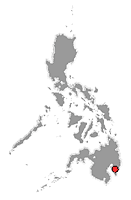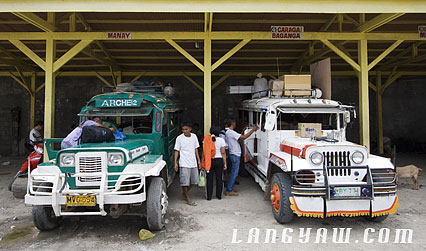
 The slow road to Caraga. If you want that, ride on a provincial jeepney. What usually takes 3 hours by van or four by bus can be an exasperating 6 hours by jeep. If you are short on patience, then forget about it. There are just too many stops, too many waits, too many bad roads coupled with a heavy downpour.
The slow road to Caraga. If you want that, ride on a provincial jeepney. What usually takes 3 hours by van or four by bus can be an exasperating 6 hours by jeep. If you are short on patience, then forget about it. There are just too many stops, too many waits, too many bad roads coupled with a heavy downpour.
After leaving the jeep terminal, you would think that you are already on your way. But it detours to the market where it will stay for an hour to wait and haul the produce that a passenger will be buying. Then a trip to the gasoline station where several containers numbering around 10 will be filled with fuel for a good 30 minutes. Then off you go to another waiting area, another 1 hour before finally, you are on the highway up north.
However, after a few kilometers, a passenger alights. Then another few kilometers and a passenger rides. Produce has to be delivered and loaded. The vehicle breaks down and then repaired. Then at a terminal in one of the municipalities, the jeep stops for merienda until there just comes a point wherein you’re silently cursing on why, in the first place you rode this jeepney. But all you can do is sit it out, bear it and make the most of it.
Now, will you still opt to go slow to Caraga? Think again!

At the terminal in Mati. These heavy duty jeepney with windshields opened are built bigger than the usual found in the city. In some instances, it becomes a mini six-wheeler in order to traverse rough terrain that becomes muddy during the rainy season.

These goats are loaded in a tricyle at the terminal. Thank God, these were not part of the cargo for the jeepney I rode.

For long trips like this, always opt to have a front seat. Or if you want a little comfort, pay for the two seats beside the driver so you can have it solo and have a bigger elbow room to spare. I’m not really sure why the windshield is done like this, which can also be seen in other areas, but when it rain, these are closed shut.

A jeepney loaded to the roof with produce, things and passengers. A common sight in Davao Oriental and in most far flung places in the country. As public transport are few passengers don’t have much choice but to cram things in and squeeze. But sometimes, for a traveler/adventurer, getting a seat up the roof is one of the best way to experience local life as well as to enjoy the scenery.
Just hold on tight.
you have a great site bro! i wish i could travel as much as you have. i’ve been to davao too but i only stayed for a two-day conference. too bad i only saw parts of the city. the countryside is one of the best sights to see around the country. my next vacation with my wife will probably be CDO.
also thanks for visiting my site too! more power to you!
part of transPOORtation natin yan…sa butuan pa lang ako nakarating dyan
tutubi, despite the experience, its something that a traveler ought to do for the heck of it. hahaha
havent been to this part of Mindanao. Caraga is actually the name of our region comprising surigaos norte and sur, and agusans norte and sur. Perhaps the name of the region was derived from this place in mati.
bai, i’m not really sure where it is derived since as early as the 18th century (or maybe 19th), Caraga has already been used to denote northeast Mindanao. You should go there, duol ra na 🙂
I knew how it feels to be trying to stretch your patience when the jeep makes several and very long stopover on the way to ur destination.
many years back, jeepneys will have to cross rivers as bridges were not yet constructed then. i have experienced being in a jeep stuck in the middle of a flooded river and we, as kids, had to be placed atop for safety. We waited until a big truck came along and towed our jeep to the bank. Back then, there were stories of jeepneys being sept away to the ocean.
I’d been in Mati and its neigboring towns sometime in 1993. I’ve never been back there up until now.
By the way, I’d like to share with you some photos that basically look almost exactly as what you have there in the last photo of this entry. Please see it here: http://travelogue.digitalrebel.ws/2009/01/biyaheng-langit-photo-essay.html
Keep it up Estan, we may not have chance to travel often as you did but we are lucky to have a chance to view your Site that make us aware of things that you have encountered during the travel, thank you for making this site available. you did a great job dude